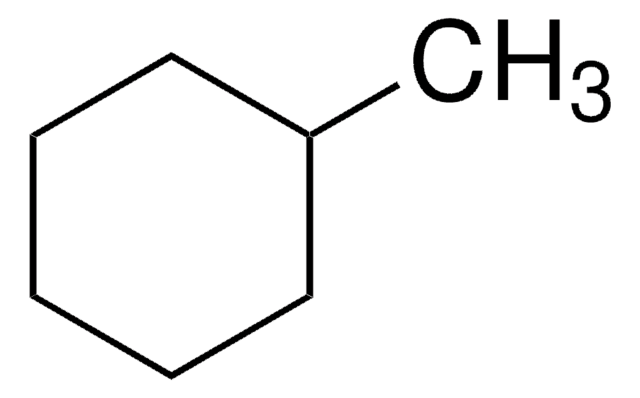About This Item
77 mmHg ( 20 °C)
Recommended Products
grade
anhydrous
Quality Level
vapor density
2.9 (vs air)
vapor pressure
168.8 mmHg ( 37.7 °C)
77 mmHg ( 20 °C)
Assay
99.5%
form
liquid
autoignition temp.
500 °F
expl. lim.
9 %
impurities
<0.001% water
<0.005% water (100 mL pkg)
evapn. residue
<0.0005%
color
colorless
refractive index
n20/D 1.426 (lit.)
bp
80.7 °C (lit.)
mp
4-7 °C (lit.)
density
0.779 g/mL at 25 °C (lit.)
SMILES string
C1CCCCC1
InChI
1S/C6H12/c1-2-4-6-5-3-1/h1-6H2
InChI key
XDTMQSROBMDMFD-UHFFFAOYSA-N
Looking for similar products? Visit Product Comparison Guide
General description
Application
Packaging
Other Notes
Signal Word
Danger
Hazard Statements
Precautionary Statements
Hazard Classifications
Aquatic Acute 1 - Aquatic Chronic 1 - Asp. Tox. 1 - Flam. Liq. 2 - Skin Irrit. 2 - STOT SE 3
Target Organs
Central nervous system
Storage Class Code
3 - Flammable liquids
WGK
WGK 2
Flash Point(F)
-4.0 °F - closed cup
Flash Point(C)
-20 °C - closed cup
Personal Protective Equipment
Regulatory Listings
Regulatory Listings are mainly provided for chemical products. Only limited information can be provided here for non-chemical products. No entry means none of the components are listed. It is the user’s obligation to ensure the safe and legal use of the product.
PRTR
Class I Designated Chemical Substances
FSL
Group 4: Flammable liquids
Type 1 petroleums
Hazardous rank II
Water insoluble liquid
ISHL Indicated Name
Substances Subject to be Indicated Names
ISHL Notified Names
Substances Subject to be Notified Names
JAN Code
227048-250ML:
227048-18L:
227048-8L:
227048-VAR:
227048-4X2L:
227048-PZ:
227048-200L:
227048-2L:4548173932637
227048-BULK:
227048-100ML:4548173932613
227048-20L:
227048-6X1L:
227048-2.5L:4548173371634
227048-1L:4548173932620
Choose from one of the most recent versions:
Already Own This Product?
Find documentation for the products that you have recently purchased in the Document Library.
Customers Also Viewed
Our team of scientists has experience in all areas of research including Life Science, Material Science, Chemical Synthesis, Chromatography, Analytical and many others.
Contact Technical Service










